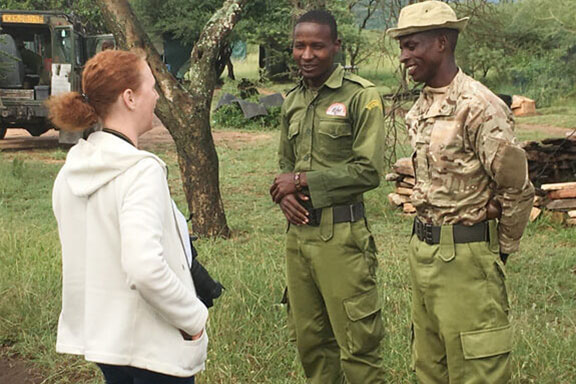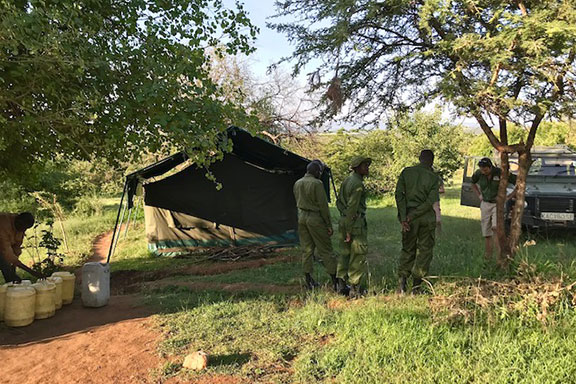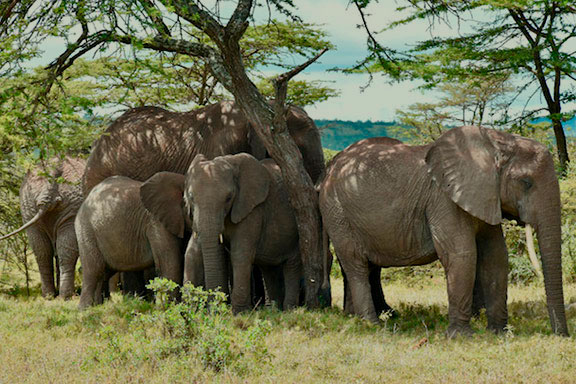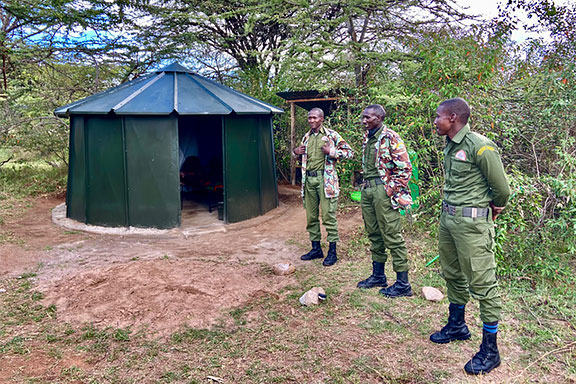Kerstin Bucher from Future for Elephants has been involved with Elephant Aware Masai Mara for many years and visits this project regularly. Over the years a deep friendship has developed with the Cowell family, the founders of the organization and the rangers.
After I could not travel to Kenya in 2020 due to the corona pandemic, I was even more happy to visit Elephant Aware Masai Mara in Siana/Kenya this year, even if unfortunately only for a very short time due to corona.
 Personal contact with the people of our projects on the ground is incredibly important, as it gives us direct insight into the daily work of the organization.
Personal contact with the people of our projects on the ground is incredibly important, as it gives us direct insight into the daily work of the organization.
After a 5-hour drive from Nairobi with a stopover in Narok to do some shopping, we arrived at Elephant Aware Camp in the late afternoon. It was nice to see that all the Cowell family members and the rangers are doing well despite the pandemic, here in the African bush away from population centers such as Nairobi or Narok. The two sniffer dogs, Derry and Buster, are also doing very well, despite their advanced age. The sniffer dogs are an important support for the rangers on their patrols and an unbeatable tool in the fight against poaching.
Sirwue, an orphaned eland antelope lovingly raised by the Cowells, is also still found in the main camp despite being 6 years old. Somehow she seems not to have heard the call of the wild to this day, although there are several herds of this antelope species near the camp.
Immediately after arriving at the camp, we were guided by Will and Gini to the important new ranger base. It is located next to the Porogo base, which was established in 2019, and is the second ranger base to be established. Both the Olendaini and Porogo ranger bases were established on Maasai communal land, and are located in strategic locations. Here, the rangers can monitor the elephants around the clock and respond quickly to problem reports from Maasai communities to intervene and mediate in human-elephant conflicts or human-wildlife conflicts. At the time of our stay, rangers Keruki, Lilanka and Kishoyian were on duty at the new Olendaini ranger base. These services last 14 days, then the team is rotated out.

In total, Elephant Aware now has 3 operational bases, Porogo, Olendaini and the main camp as the central hub of the project, allowing it to better respond to the wide range of problems. At the main camp, a newly constructed carport provides space for the project Landrovers, and two small motorcycles. On the one hand these are used for small supply trips by the rangers, on the other hand they also serve as so-called fast mobile emergency vehicles in case of emergency.
Unfortunately it became again very clear that more and more land of the Maasai between the Mara Siana Conservancy and other conservancies like Naboisho is fenced in and the movements of the elephants or wild animals are increasingly restricted.
Therefore, a very central task of the Elephant Aware Team is to keep important migratory routes for elephants clear and preserved by having the rangers on the ground try to convince local people of the need for such corridors. Elephant and wildlife conservation only works if you get the local people on board.
The next day in camp was dedicated to elephants. The rangers had told us the position of a small herd of elephants by cell phone and after breakfast we went with Gini Cowell and her mother Elisabeth to the gray giants. We met Eseseri, Mags (whom I have known since 2016) and their families resting peacefully under a shady acacia tree together with a large bull. The youngest had partially lain down in the shade of the larger elephants. They could only be heard breathing and occasionally rumbling. What a peaceful scene! Later in the afternoon we were able to sight Eluai and her family.
 The rangers spend a lot of time with the elephants. This is an essential part of their work. Therefore they know the animals very well and can identify them. During the observations, the rangers check if the animals are doing well or if there are any injuries that might require medical intervention or if there might be a conflict brewing. The well-organized monitoring ensures that the elephants remain safe during their migrations and that conflict situations can be largely avoided.
The rangers spend a lot of time with the elephants. This is an essential part of their work. Therefore they know the animals very well and can identify them. During the observations, the rangers check if the animals are doing well or if there are any injuries that might require medical intervention or if there might be a conflict brewing. The well-organized monitoring ensures that the elephants remain safe during their migrations and that conflict situations can be largely avoided.

After returning to the camp, we met a herd of zebras, which is probably a frequent visitor here. Also a small foal was with them. During lunch time a herd of elephants moved peacefully through the Elephant Aware Camp.
After one and a half days in Siana it was time to say goodbye to the Cowells and the rangers. Despite the short stay, I could again see for myself the dedication and commitment with which the EAMM team works. The short insight into the daily work of the rangers gives hope that despite the increasing pressure in Siana, the wildlife of this unique ecosystem has a chance for a future.
Being "one" with their environment, as rangers often are, is a truly important skill when it comes to protecting wildlife and their habitat. Elephant Aware's rangers have grown up in their area of operation. They have a specific knowledge of that area. This is incredibly valuable to their work. This is one of the many reasons why rangers and a "boots on the ground" approach are one of the most effective tools for species conservation.
More about Elephant Aware Masai Mara:
https://www.futureforelephants.org/schutzprojekte/kenia-maasai-mara

